Originally made of wood, and of motte and bailey design, Windsor Castle was built upon a fifty foot mound of chalk excavated from the surrounding ditch.
Ordered by William the Conqueror to guard against western approaches to London, the site was strategically chosen high above the river Thames and just a day’s march from the capital and another famous Norman landmark the Tower of London.
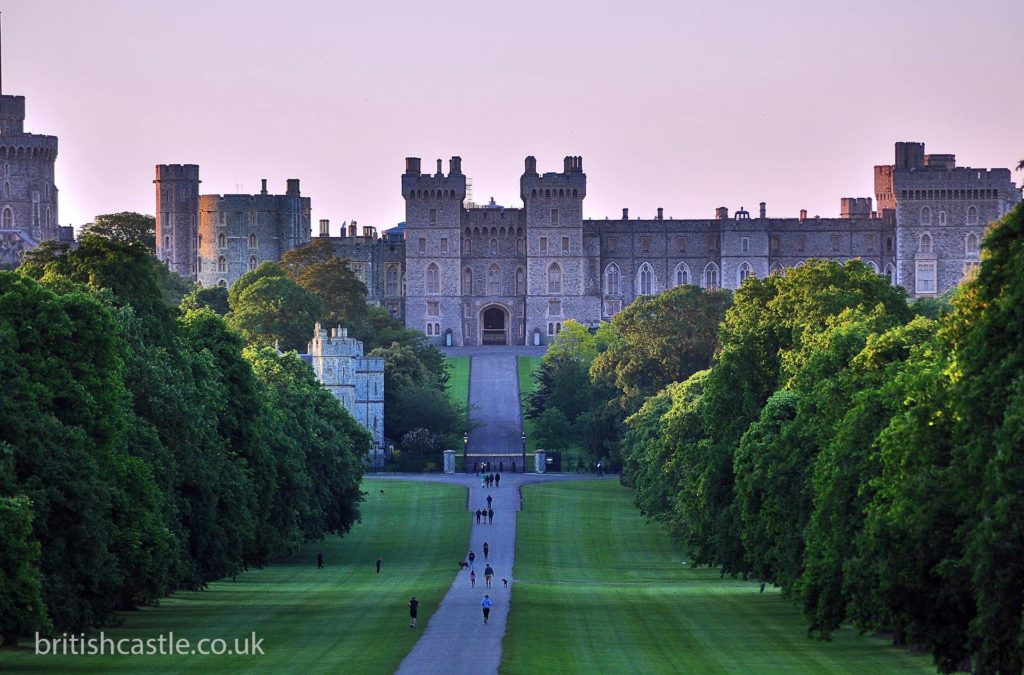
They were just two of many fortifications constructed, following his army’s invasion of the British Isles, to establish and maintain control of the newly acquired realm.
Today Windsor Castle is one of the King’s principal official residences. The state apartments, first opened to the public in 1845 during the reign of Queen Victoria, contain some of the finest works of art in the world. There are masterpieces by Rembrandt, Rubens, Holbein and Van Dyck as well as magnificent French and English furniture and priceless pieces of porcelain.
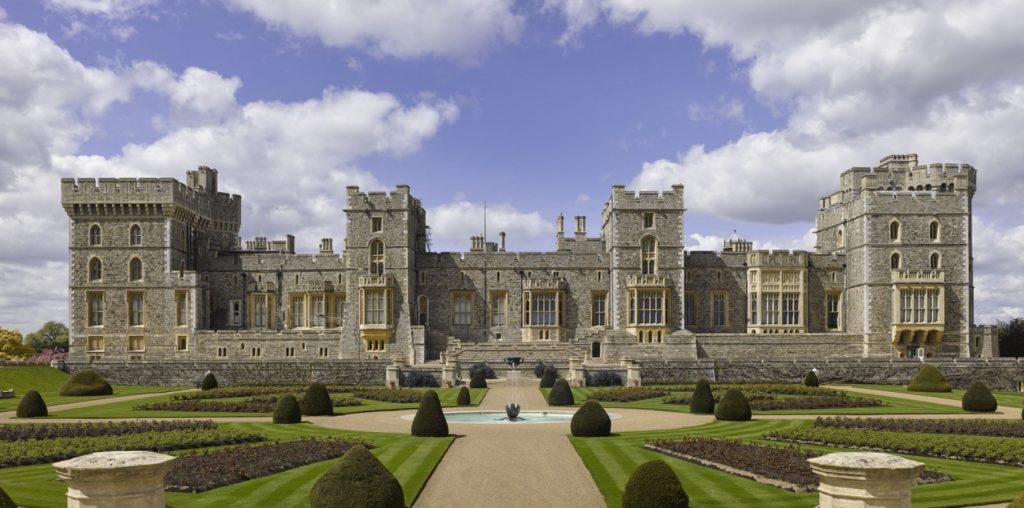
The most prominent and widely visible architectural feature, the Round Tower, is not truly cylindrical its shape dictated by the irregular, though seemingly round, man made hill on which it sits. The Lower Ward is home to Saint George’s Chapel. Within the Upper Ward are the private Royal Apartments. Also evident in the Upper Ward, discovered during recent archaeological investigations, are foundations of the building housing the Knight’s of the Garter’s round table.
Allow us to regale you with a selection of Windsor Castle facts that you can use to impress your friends with.
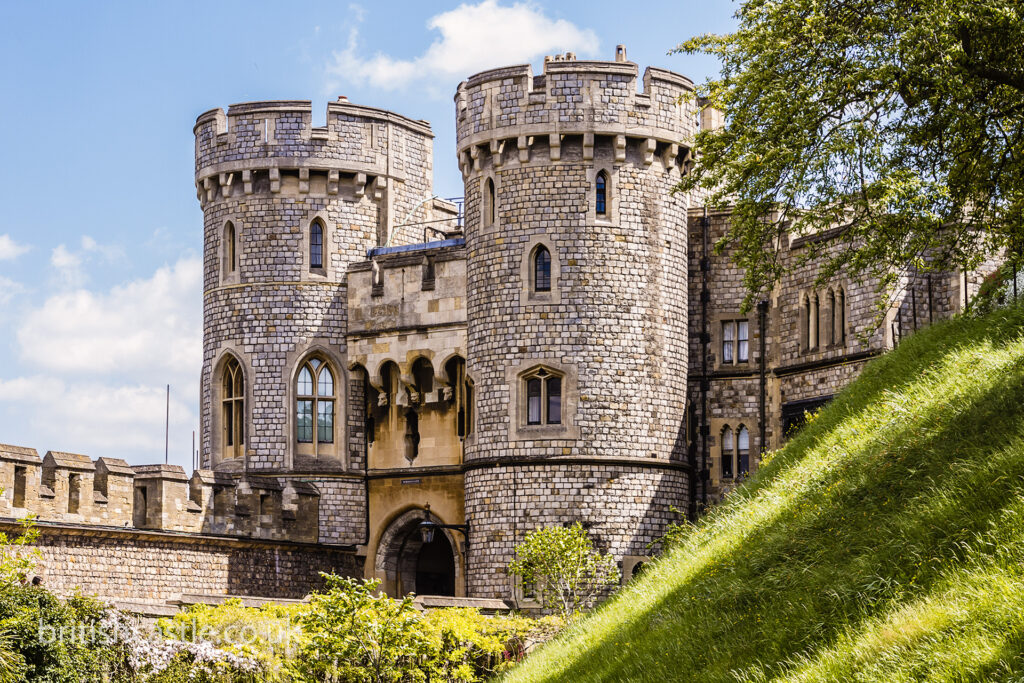
When was Windsor Castle Built?
Windsor Castle is one of the UK’s most iconic and famous landmarks. You can find the stunning royal residence in the town of Windsor, in Berkshire, in south east England. It has been the home of English kings and queens for almost 1000 years and has seen some remarkable transformations over its history.
This historic castle has been the site of many significant events in British history, including coronations, weddings, and state occasions. In fact, learning about the castle’s history is like taking a crash course in the history of the British monarchy.
The construction date of Windsor Castle traces back to the 11th century, making it a significant historical landmark in the UK
In this article, we’ll discuss the history of Windsor Castle, when it was built, its architecture, its significance to the British monarchy, and a whole lot more.
If you are looking for Windsor Castle info, then please read on.
The Early Years
Windsor Castle is over 950 years old. It was built in the 11th century by William the Conqueror shortly after the Norman Invasion of Britain. He reigned between 1066 and 1087, and his original castle stood on the site of today’s Round Tower.
The original construction was quite simple. It consisted of a motte (a raised hill) and two baileys or walled courtyards. William built the castle as a defensive fortress to protect the western approach to London. The castle was initially constructed from wood, but subsequent rulers replaced it with stone over time.
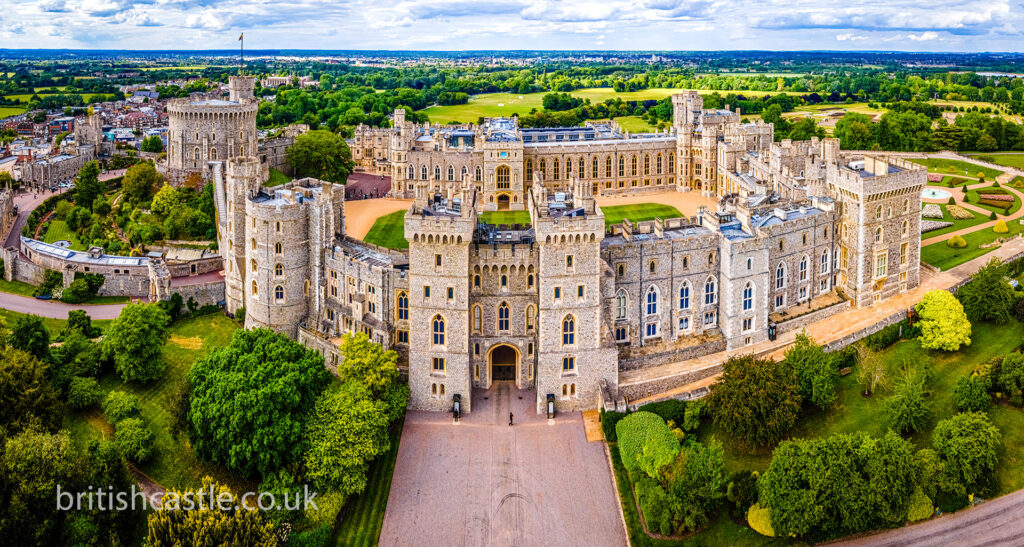
The site of the castle also had strategic importance to William. It was built close to the River Thames and surrounding forests. This location provided a reliable source of food and wood.
With such a long history, many people ask, “Is Windsor Castle the oldest castle in the world?” That title belongs to the Citadel of Aleppo in Syria, with some parts of the fortified palace dating back to 3000 BC. However, Windsor Castle is actually the oldest occupied castle in the world. It has never laid empty since it was first built in the later part of the 11th century.
Windsor’s Beginnings
To track back the history of Windsor Castle, we need to discuss the Norman invasion of England. The origins of that takeover began in Normandy in the early part of the 10th century. A group of Vikings was allowed to settle in Northern France by the then rulers in exchange for protection from other bands of Nordic raiders. They quickly assimilated and began to be known as Northmen, which evolved in Norman and Normandy.
About 100 years later, the Saxon king of England, Æthelred the Unready, married Emma of Normandy. The pair had a son called Edward the Confessor. In 1016, Cnut the Great invaded England, and Edward was forced into exile in Normandy.
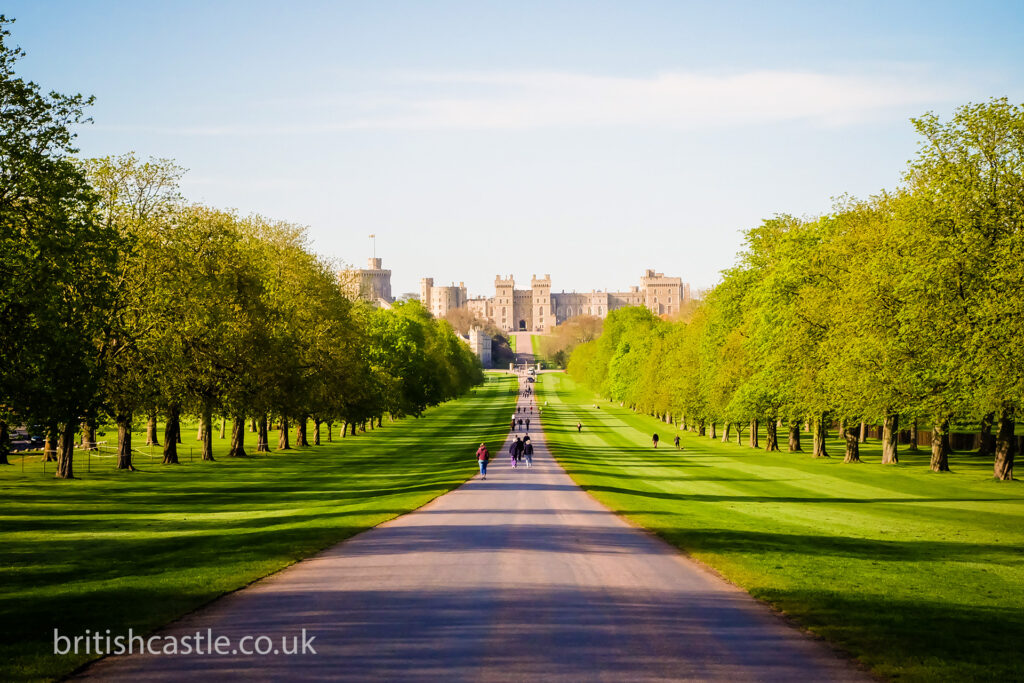
However, in 1042, Edward restored the House of Wessex rule and led the country for the next 22 years. During that time, he worked closely with the Normans and appointed many of their numbers to positions of power, particularly in the clergy.
King Edward was childless, so when he died in 1066, several contenders were vying for the throne. The king’s council appointed Harold Godwinson, the Earl of Wessex.
Duke William of Normandy and King Harald III of Norway both felt they were the rightful rulers, and they joined forces and attacked England. Harald attacked from the north but was beaten by Godwinson’s forces.
However, a few days later, William’s army landed in southern England and won the Battle of Hastings. Harold was killed, and William the Conqueror became King of England.
The site of the castle was strategically important. It was close to the Thames, London, and the bountiful hunting ground. It would also protect against attacks on London from the western approach.
At first, the castle was limited. Built on an artificial mound, it was a cube-shaped defensive structure. Despite winning the throne, William was subject to many rebellions and only truly established his rule in 1972. As such, it was a far cry from the lavish comfort of the present-day Windsor Castle and could more accurately be described as functional.
Early history (1070–1350)
William the Conqueror commissioned the construction of Windsor Castle in 1070. It took 16 years to complete. However, his primary residence was the tower of London. His idea behind Windsor castle was to form part of a ring of fortifications around the capital to protect against rivals for the throne.
The original castle, made from wood, was situated where you can find the present-day Round Tower. Historians believe the site was once a Saxon royal residence in what is now called Old Windsor. The Domesday Book suggests the Manor of Clewer owned the land. It is believed that William leased the land from the Manor to begin his work.
What is interesting about the early history of Windsor Castle is that it seems to have been built as little more than a military base. However, Williams’ youngest son, Henry I, was the first royal to make it his residence.
After the death of William the Conqueror, his son William II ordered the improvement and further fortification of the castle. However, he was succeeded by his brother Henry I in 1100.
The reign of Henry I is remembered for bitter infighting; his brother Duke Robert was fighting the Crusades at the time of William II’s death from a hunting accident, and Henry took advantage of his absence to become king.
However, it was not a popular appointment. Indeed, Henry I feared for his safety and took up residence at Windsor Castle for protection. This moment can be seen as the start of the tradition of royal leaders making the castle their primary home.
As time went on, rulers gradually upgraded the castle. Henry I’s successor, Henry II, replaced the wooden palisades with stone walls in 1154. These new walls also featured square watch towers. He also added the first stone keep at the castle’s centre.
By 1189, the castle was under attack. Henry II was succeeded by Richard the Lionheart. However, his son Prince John was a resident at the castle and was forced to flee the country. Later, in 1216, the castle sustained severe damage during the First Barons War.
King John died from dysentery in 1216. His successor, Henry III, ordered the repair of the castle. This upgrade involved the creation of a curtain wall to the west. Much of this wall can still be seen there today. Additionally, later work involved the construction of a curfew tower in 1227.
For the next 100 years, until the 50-year reign of Edward the III in 1237, not many building works of note were done to the Castle. However, that would all change when Edward of Windsor took charge.
Windsor Castle from 1350
The reign of King Edward III was notable for many reasons. Known as Edward of Windsor, he was born in the castle in 1312. He was famed for his military might and having declared himself the rightful heir to the French throne, he started the Hundred Year War.
His influence on Windsor was immense. In 1350, he began the process of modernising the castle. These works would take more than 20 years and involve demolishing the existing castle, with the exception of the Curfew Tower built under Henry III.
Many of these new developments were overseen by the appointment of William of Wykeham as the designer and builder of the new Windsor Castle. William was a fascinating character, and he held roles such as the Bishop of Winchester and Chancellor of England. He founded and built New College, Oxford, and New College School in 1379 before he founded Winchester College in 1382.
Some of the work that happened to Windsor Castle at this time included replacing King Henry II’s Round Tower with a new keep, parts of which still stand today.
Additional works include the expansion of the chapel and a beefing up of the fortifications. Historians suggest that plans to build a church were shelved, possibly because the Black Death made labour and resources hard to come by.
One intriguing story from William of Wykeham’s time at Windsor involves him engraving the words HOC FECIT WYKEHAM on the nave of the chapel. These carvings translate as “William made this”. However, when King Edward III asked him about what he meant, William suggested that he wasn’t saying that he made the castle, but rather that the castle made him because it afforded him such an opportunity. A lucky escape, no doubt!
Other notable additions from the time are the Aerary Porch at St. George’s Chapel. It was built in 1153-54 and was used as the entrance to the new college.
Indeed, St. George’s Chapel was the next building in the castle to undergo major renovations during the days of Richard II, who was just ten years old when he succeeded Edward III. The chapel was surveyed and declared close to collapse, forcing the monarch into action.
Writer, poet, and the arguable father of English Literature, Geoffrey Chaucer oversaw the work as Clerk of Works at Windsor Castle. The young Richard was a huge fan of The Canterbury Tales writer, and their relationship remained close until Chaucer’s death. Interestingly, both men are said to have died in 1400, by which time Richard II was dethroned.
However, while Chaucer is known for superbly constructing a plot, his work as a builder has not stood the test of time. Within a short space of 50 years, St. George’s Chapel was in ruins and crying out for help.
Between 1319 and 1471, Henry IV, Henry V, and Henry VI all reigned. However, it wasn’t until the time of King Edward IV that the construction of St. George’s Chapel as we know it today was started.
While King Edward began the works in 1475, King Henry VIII was in power by the time it was completed. The construction of St. George’s Chapel marks a shift away from a more practical structure and into something more rich and decorative.
The chapel is considered a great example of the Perpendicular style, which was a late phase of Gothic architecture popular in England. Large windows, slender columns, and vertical lines are some of the hallmarks of this dramatic architectural style.
Windsor Castle Becomes Lavish
The new St. George’s Chapel was emblematic of a change in circumstances for the royals. The civil war, called The Wars of the Roses, raged between 1455 – 1485. However, once it was over, the country entered a period of political stability.
Windsor Castle’s evolution from a military stronghold into a lavish royal palace was underway. Style and comfort were in, as practical utility and protection became less of a priority.
During this era, the curved building called the Horseshoe Cloisters was built by Edward IV. While a restored version from the late 19th century still stands today, the original materials have been consigned to history.
The project of shifting Windsor Castle from a fortress to a palace began with the young King Edward III. While the building was already quite large, Edward started to expand outwards, building three courts: the Little Cloister, King’s Cloister and the Kitchen Court. Additionally, two symmetrical gatehouses were also constructed. The Kitchen Gatehouse led to the kitchen courtyard; however, the Spicery Gatehouse became the palace’s main entrance.
This time also saw the construction of the Rose Tower in the western corner of the grounds. It was built for Edward’s private use, and these days it goes by the name King John’s Tower. Modern-day reconstructions of his private space give a fascinating insight into how the king lived.
Edward III was also responsible for building a series of plush, self-contained court lodgings in the Upper Ward. The west entrance was secured by a Norman gate, while the chapel in the Lower Ward was expanded, with new buildings created to hold canons.
However, despite this progress, Windsor still paled in comparison to other royal residences of the time. But in time, it would rival any palace for opulence.
The English Civil War
Just before the English Civil War was a relatively quiet time for the palace. Neither James I nor Charles I did anything too notable to the castle.
Charles I did have some plans and sought the services of Indigo Jones. However, the king did not carry out the recommended works. Instead, all he commissioned were a gateway in the North Terrace and some repairs in the chapel.
In 1642, the English Civil War split the country. Royalist supporters of Charles clashed with the Parliamentarians and won. The victorious Parliament worried Charles I would attempt to capture London, so the politician John Venn took over the castle as governor.
Thus began a sad time for the castle. The soldiers stationed at the royal court now were unpaid. Soon, they began to look at Windsor for all it was worth. They stole gold, silver, and jewels, while books and the church organ were destroyed.
The castle was a military base. The Parliamentarians also used it to house royal prisoners, including Charles I. After several royal attempts to retake the castle, Charles was executed. His remains were returned to the castle and buried in the vault below St. George’s Castle.
Cromwell remained in charge until the restoration of the monarchy in 1660.
The restoration of the monarchy in 1660
The Interregnum was the period between 1649 and 1660 when Charles I was executed and Charles II returned from exile. During this time, England cycled through a variety of Republican governments.
However, when Charles II issued the Declaration of Breda, he returned to the crown. Charles II was instrumental in the restoration and repair of the castle following 19 years of destruction and neglect.
After the Restoration, Charles appointed his close relative Prince Rupert of the Rhine to the post of Constable of Windsor Castle in 1668. His work involved repairing the castle defences, rebuilding the Royal Tower and restoring the real tennis court, all of which had been damaged by squatters and looters.
Inspired by the Palace of Versailles, Charles II commissioned the Long Walk. This 2.64-mile stretch of road expanded into Windsor Deer Park, extending from the private Home Park all the way out to George IV Gate. Implemented in 1680, it was developed in 1683 to its current length, with the addition of the iconic Copper Horse not added until the 19th century. The original Long Walk was lined with oak trees at first.
The King also commanded a rebuild of the Royal Apartments and St George’s Hall. The architect Hugh May played a huge role in the restoration. He remodelled the Upper Ward, extending the Royal Apartments. Additionally, he rebuilt St George’s Hall and the Royal Chapel after they had fallen into disrepair during the Interregnum.
However, some of May’s most interesting works at Windsor were a collection of baroque interiors. Perhaps the most notable was the interior of St George’s Hall. Sadly, it was demolished in 1826, but two examples of his interiors survive today, albeit with some alterations. These are the Queen’s Audience Chamber and Presence Chamber, both of which can give you an idea of how St. Georges Hall may have looked.
Indeed, the interiors were a priority for Charles. He brought paintings and tapestries to furnish the rooms of the castle. A considerable number of these pieces of art are still there today and are part of what is now called the Royal Collection. Alongside the Queen’s Audience Chamber and Presence Chamber, the King’s Dining Room has changed very little in the intervening years.
Overall, around twenty rooms were remodelled in this iconic style. The Italian painter Antonio Verrio created dramatic ceiling murals, while the Anglo-Dutch wood carver Grinling Gibbons was responsible for creating some exquisite wall carvings and panelling.
The influence of Louis XIV’s style extended beyond the Long Walk and the Interiors. To satisfy French court protocol, May built a series of rooms that were aligned together in what is known as enfiladed. Building out from the North Terrace, this new structure earned the name The Star Building because of the substantial gilt Garter star placed on its side by Charles II.
His reign is remembered fondly as a great time for the development of the castle. His interest and commitment to modern European art revived the palace, and it remains some of its most beautiful work.
However, his death would mark another dark chapter in the palace’s history. The short-lived reign of his brother James II was followed by the invasion of William of Orange. Breaking the bloodline, these Protestant rulers shared the throne as William III and had Mary II.
William did have some plans for the castle. For example, he commissioned an extensive remodelling of the Upper Ward. He even went as far as appointing Sir Christopher Wren and Nicholas Hawksmoor to complete the work. However, his death from pneumonia in 1702 halted his grand plans.
The Eighteenth Century
Queen Anne’s reign began at the start of the 18th century. However, just like William III and Mary II before her, she preferred not to live at Windsor. William and Mary had transformed Hampton Court Palace, and it became their place of residence. On the other hand, Queen Anne preferred to live in a small house near the palace walls.
That’s not to say that she didn’t like the palace, of course. Indeed, Anne had plans to build a formal garden. She even instructed the prominent designer Henry Wise to work on the project, but it was never completed.
Queen Anne’s life was marked by ill health. She died at the age of 49 and was succeeded by George I. The Parliament had settled on Sophia, Electress of Hanover as Queen Anne’s successor, but she died two months before. As a result, her son became King.
However, George I continued the line of rulers who preferred to live in other palaces. He predominantly used Hampton Court, Kensington, and St James’s Palace, leaving Windsor to once again fall into a period of neglect. During his time, Upper Ward apartments were handed out to friends of the crown and prominent widows.
The 1740s marked the time when Windsor Castle became a tourist attraction. At first, only wealthy visitors came to see the palace, but as time went on, members of the public were able to visit with regularity. However, this coincided with the deterioration of the State Apartments as the castle was not viewed as a priority for the king.
The reign of George III would change all of that. He disliked Hampton Court Palace and was drawn to Windsor’s Deer Park. His first preference was the Ranger’s House, situated by the palace. However, this was his brother Henry’s home, and he remarkably refused to move out.
Instead, George occupied the Upper Lodge, now called the Queen’s Lodge. Thus began the long process of renovation after years of neglect. The castle and its surrounding parks were remade. George, the father of 13 children, needed the space, and Windsor was once again buzzing with signs of life.
Under George’s command, the preferred architectural style changed and evolved. An early preference for classical styles, particularly Palladian, soon gave way to Gothic. In part, this was seen as a more English style of design.
George III hired the esteemed architect James Wyatt. The idea was to take on the Upper Ward and turn it into a Gothic palace. However, the interiors would keep their existing feel. The exteriors were afforded new features in the Gothic style. Some of the most notable were turrets and battlements. The interior remodelling included gothic stairs with a grand vestibule ceiling.
Another aspect of the new works involved the purchase of new paintings and the relocation of other art from other royal palaces. The Great Park was also improved with new lakes, grottos, and other follies added to the existing features. The total cost of the works is said to be about $100m or more in today’s terms.
When some of the works were completed, the palace was, once again, the primary residence of the royals. In 1788 the king was diagnosed with “madness”, and while he recovered, subsequent relapses and a deterioration of his condition led to his confinement in the State Apartments. The extensive building work stopped that year.
The Nineteenth Century
George IV’s ascension to the throne in 1820 coincided with a remarkable period of growth and power for Britain. He had grand designs for a palace fit for a man of his means and influence. Time under George IV would see the most extensive and ambitious remodel of the palace’s history.
During his regency, he had been involved in extensive expansions of Brighton Pavilion and Carlton house. Additionally, he had expanded the Royal Lodge in the castle park. Soon, as king, he would turn his ambitions to the castle itself. Securing about £300,000, over £300 million in today’s terms, from parliaments, he selected Jeffry Wyatville as his architect.
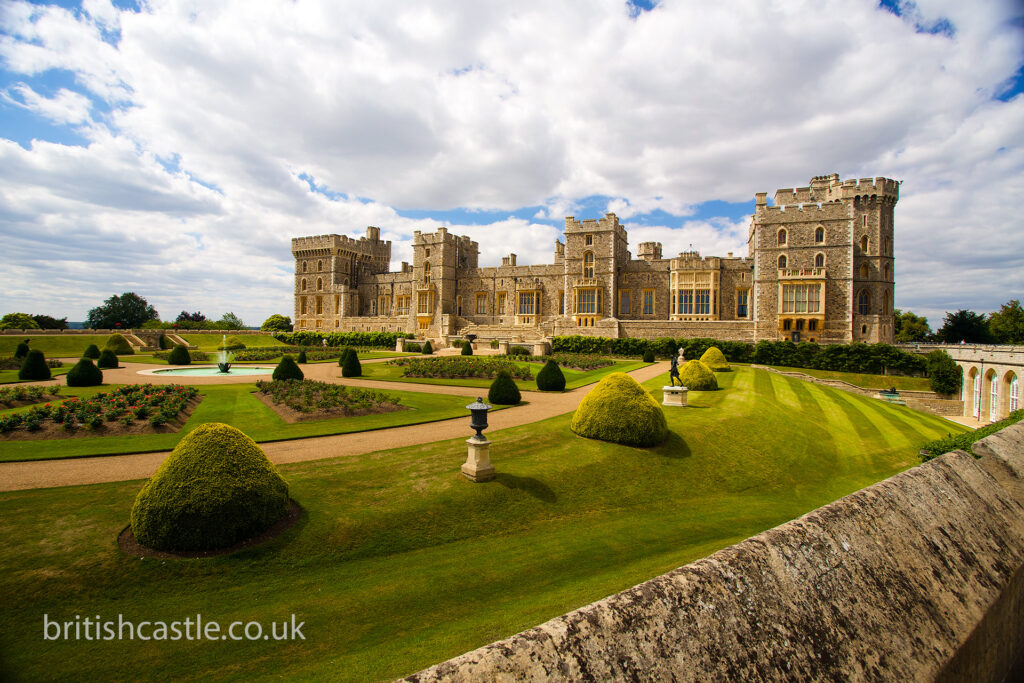
Work started in 1824; white Wyatt was known for his gothic style, George IV preferred the French rococo style, alongside a mix of different architectural styles. He imposed his tastes on Windsor.
Some of the notable work completed include remodelling the exterior of the upper ward into the current day appearance. Additionally, the Round Tower was raised dramatically in height, with several new towers built that dwarfed the initial towers. State apartments also were upgraded, while a statue of Charles II was moved from the Upper Ward to the base of the motte.
While this mix of styles was unique, not everyone approved. Over the years, many people, including the current King, have lamented the alterations to May’s more restrained early work. When George IV died, work was still ongoing. It was more or less done by the time Wyatville passed. However, it had run significantly over budget, with an estimated cost of almost £1 billion in today’s money.
The Victorian era
When Queen Victoria and Prince Albert succeeded George IV, they made Windsor Castle their principal residence. However, early in her reign Victoria suggested the castle was dull and prison-like. The changes the pair made to the court were mainly focused on the castle grounds.
Parliament passed the Windsor Castle and Town Approaches Act in 1848. The act closed and rerouted roads that ran through the park. These changes led to the formation of the private “Home Park”.
However, the growth of the British Empire and Victoria’s relationship with other European dynasties meant the castle soon became the epicentre of diplomatic and state visits. Many people regard this as the castle’s high watermark of social life.
Queen Victoria was very involved and took a hands-on role in the social aspects. However, some suggest these affairs were excessively formal, with others saying the castle made for an uncomfortable stay.
Upon Albert’s death in 1961 in Windsor castle’s Blue Room, Victoria entered a long-term stage of mourning. She retreated to the castle and kept the rooms as they were during Albert’s death. Queen Victoria stopped using Buckingham Palace and instead used Windsor for business. However, before the end of her reign, she permitted the use of the castle for opera, plays, and other forms of entertainment.
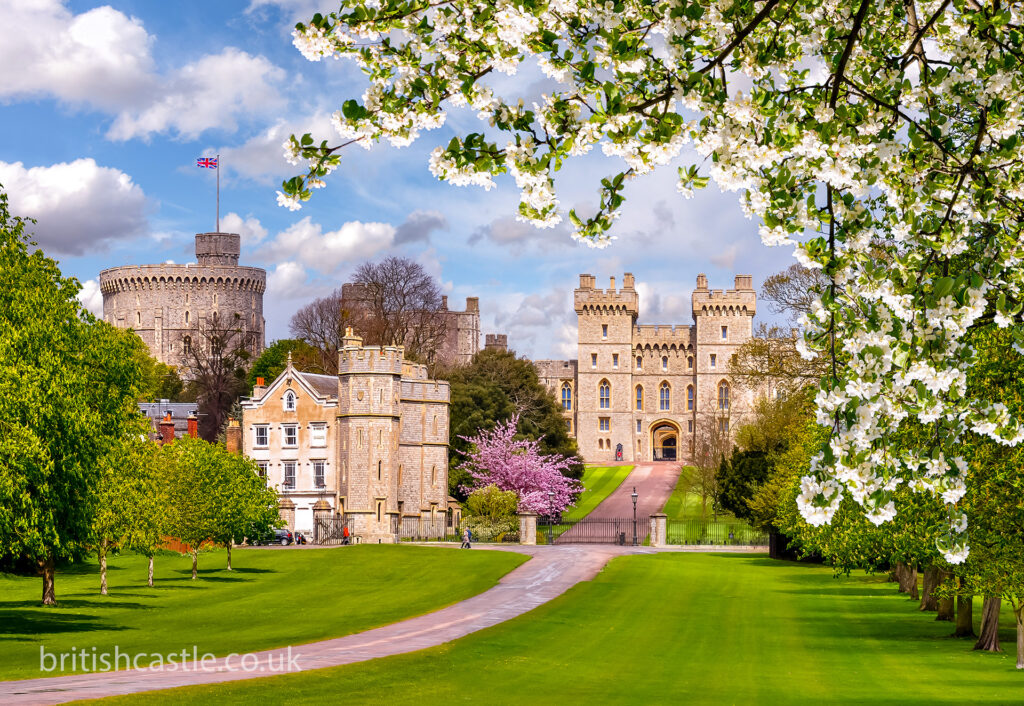
Some of the changes that happened under Victoria were Anthony Salvador’s rebuild of the Wyatville staircase. Additionally, the state apartments received a private chapel. A fire in 1853 had damaged the state dining room; this was also fixed up by Salvador. Queen’s Private Audience Chamber and Lower Ward were both extensively reworked, Garter, Curfew and Salisbury towers were rebuilt, and a new guardhouse completed the works.
Interestingly, gas-lit properties were becoming commonplace at the time. However, Queen Victoria preferred candles. As a result, electric lights were only fitted close to the end of her rain. Other modern updates, including piped water, were slowly added during this period.
Surrounding parks and buildings were extensively updated during Queen Victoria’s time. Frogmore’s Royal Dairy was turned into a mock Tudor Beauty in 1853, while George III’s was rebuilt in a Renaissance style in 1859, and the Long Walk’s elms were replaced due to elms disease.
20th century
After Victoria’s reign, Edward VII succeeded and promised to modernise the palace. The Upper Ward was redecorated and streamlined, with much of the clutter removed. Many ornaments and relics were relocated to a new room in the Round Tower. In keeping with the time, Edward VII added central heating, telephones, electric lights, and garages for automobiles.
Alongside Mary of Teck, George V continued the modernisation. Furniture that had been lost or sold by Edward VII was repurchased, and new works of art were added to the existing collection. This time is also notable for the doll’s house, which we will address below.
During this time, around 660 servants worked at the property. However, Edward VIII was less present at Windsor. He spent most of his time at Fort Belvedere in the Great Park before he abdicated in 1936. Soon after, George VI and his wife Elizabeth moved in.
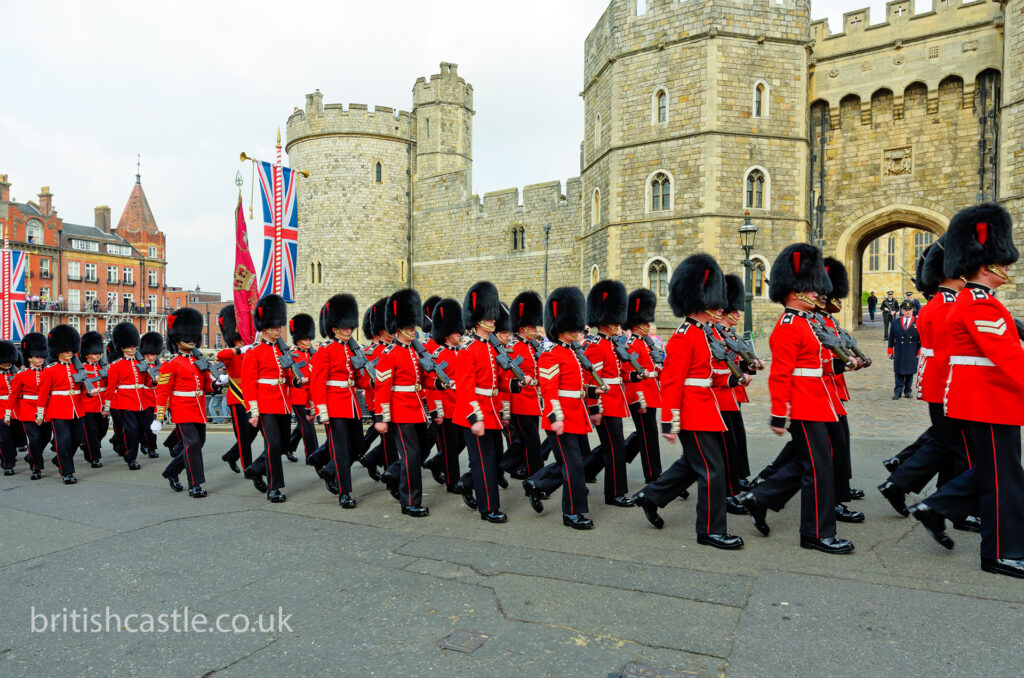
When World War II broke out, the castle was prepared for war. With worries about damage on everyone’s mind, many of the important artworks and removable features were put into safekeeping. The roof was strengthened to protect from attack, with the King, Queen and Margaret and Elizabeth continuing to live in the castle during the conflict.
In 1952, Elizabeth II came to power. She lived in Buckingham Palace but made Windsor her primary weekend residence. Private apartments that had lain dormant since Queen Mary’s rule were updated. Most of the work between the 1950 and 1990s were about preservatives and repairs rather than dramatic overhauls.
In 1992 a massive fire hit the Upper Ward. Nine staterooms were destroyed, while 100 were damaged. Alongside the fire, the palace sustained water damage. The costs of repairing the castle were 37 million, or over 70 million in today’s money.
Queen Mary’s Doll House
Queen Mary’s Dolls’ House was a project that started in the early 1920s and was completed in 1924. It was designed for Queen Mary, who was the wife of King George V.
As you might expect, the scope of the project was immense despite its miniature size. It involved the architect Sir Edwin Lutyens who devised Hyderabad House, New Delhi and British Medical Association in Tavistock Square, London, among other celebrated buildings.
The dolls’ house is a 1:12 scale. It features many replica items from Windsor Castle and contributions from dozens of artisans and craftspeople of the time. The items in the dollhouse were either made by prominent companies or professional model makers.
Some of the most remarkable features include fully plumbed toilets and functioning taps.
21st Century
Queen Elizabeth visited Windsor Castle frequently during the 21st century. However, Buckingham Palace was her main home. Windsor Castle hosted many visits by dignitaries and world leaders, including Obama, Trump, and Biden.
Most of the new works or additions during this time were about turning the castle into a tourist attraction. Updates were made to security, with hydroelectric power added.
Additionally, a new entrance and cafe were installed. Sadly, Philip and Elizabeth died within the space of about 18 months. Charles signifies the new era, with no plans for renovations announced thus far.
Windsor Castle FAQs
Q: Is Windsor Castle the oldest castle in the world?
A: Windsor Castle is the oldest occupied castle in the world. However, it’s not the world’s oldest castle. That title belongs to the Citadel of Aleppo in Syria, with some parts of the fortified place dating back to 3000 BC.
Q: How old is Windsor Castle in England?
Windsor Castle is approximately 950 years old.
Q: How old is the oldest part of Windsor Castle?
The oldest surviving part of Windsor Castle is the Curfew Tower, which was built in 1227
Q: Who originally lived in Windsor Castle?
A: Henry I was the first king to use Windsor Castle as his residence
Q: Is Windsor Castle bigger than Buckingham Palace?
A: Yes. Buckingham Palace has 775 rooms, while Windsor Castle has 1000.
Q: Is Windsor Castle the biggest house in the world?
No. Istana Nurul Iman Palace, the home of the Sultan of Brunei, holds that title.
Q: How much is Windsor Castle worth today?
Windsor Castle is estimated to be worth around £500 million.
Q: Is Windsor Castle National Trust?
No. Windsor Castle is owned by the reigning monarch. Currently King Charles III
Q: Is Buckingham Palace part of Windsor Castle?
No. They are about 20 miles apart.
Q: What is in the Round Tower at Windsor?
While there is some mystery about its exact contents, we do know that the Round Tower holds the 250-year-old Royal Archives.
Q: How tall is Windsor Castle?
The motte at Windsor is 50ft (15m) high. The castle itself is built on a chalk cliff that is around 100ft high.
Q: Was Windsor Castle built by the Normans?
Yes, William the Conqueror was the leader of the Norman invasion of England.
Q: Which English county is Windsor in?
Windsor is in Berkshire in the south east of England.
Q: What city is Windsor Castle in?
Windsor castle is in Windsor, which is an English town.
Q: Who lives in the private apartments at Windsor Castle?
Most of the apartments are unoccupied or open for public viewing. However, 150 staff live on site.
Q: Where is Windsor Castle?
Windsor Castle, nestled in Berkshire, stands as one of the oldest and most iconic royal residences in the UK
Q: Where is Windsor Castle in relation to London?
Windsor Castle is about 20 miles west of central London.
Q: Why was Windsor Castle built?
Originally, the palace was a military stronghold following the successful Norman invasion.
Visiting Windsor Castle
In recent times, Windsor Castle has become one of the most popular tourist attractions in the British Isles. Today, much of the castle is open throughout the week. Opening times, admission prices and other current information can be found by visiting the Windsor Castle website.